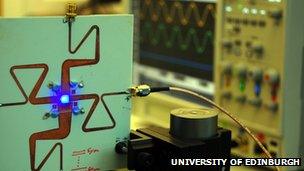'Li-fi' via LED light bulb data speed breakthrough
- Published

UK researchers say they have achieved data transmission speeds of 10Gbit/s via "li-fi" - wireless internet connectivity using light.
The researchers used a micro-LED light bulb to transmit 3.5Gbit/s via each of the three primary colours - red, green, blue - that make up white light.
This means over 10Gbit/s is possible.
Li-fi is an emerging technology that could see specialised LED lights bulbs providing low-cost wireless internet connectivity almost everywhere.
High speed
The research, known as the ultra-parallel visible light communications project, is a joint venture between the universities of Edinburgh, St Andrews, Strathclyde, Oxford, and Cambridge, and funded by the Engineering and Physical Sciences Research Council.
The tiny micro-LED bulbs, developed by the University of Strathclyde, Glasgow, allow streams of light to be beamed in parallel, each multiplying the amount of data that can be transmitted at any one time.
"If you think of a shower head separating water out into parallel streams, that's how we can make light behave," said Prof Harald Haas, an expert in optical wireless communications at the University of Edinburgh and one of the project leaders.
Using a digital modulation technique called Orthogonal Frequency Divisional Multiplexing (OFDM), researchers enabled micro-LED light bulbs to handle millions of changes in light intensity per second, effectively behaving like an extremely fast on/off switch.
This allows large chunks of binary data - a series of ones and zeros - to be transmitted at high speed.
Earlier this year, Germany's Fraunhofer Heinrich Hertz Institute claimed that data rates of up to 1Gbit/s per LED light frequency were possible in laboratory conditions.
And this month, Chinese scientists reportedly developed a microchipped LED bulb that can produce data speeds of up to 150 megabits per second (Mbps), with one bulb providing internet connectivity for four computers.
'Light fidelity'
In 2011, Prof Haas demonstrated how an LED bulb equipped with signal processing technology could stream a high-definition video to a computer.
He coined the term "light fidelity" or li-fi - also known as visual light communications (VLC) - and set up a private company, PureVLC, to exploit the technology.
Li-fi promises to be cheaper and more energy-efficient than existing wireless radio systems given the ubiquity of LED bulbs and the fact that lighting infrastructure is already in place.
Visible light is part of the electromagnetic spectrum and its bandwidth is 10,000 times bigger than the radio frequency spectrum used by existing communication systems, affording vastly greater capacity.
Another advantage, Prof Haas argues, is that evenly spaced LED transmitters could provide much more localised and consistent internet connectivity throughout buildings.
The disadvantage of traditional wi-fi routers is that the signal weakens the further you are away from it, leading to inconsistent connectivity within offices and homes.
Prof Haas also believes light's inability to penetrate walls makes VLC technology potentially more secure than traditional wi-fi connectivity.
- Published18 October 2013